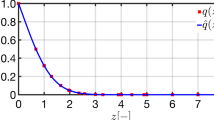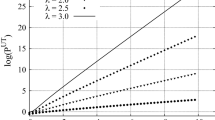Abstract
The main aim of this work is to compare various models of rubber elasticity, i.e. neo-Hookean, Mooney-Rivlin, Yeoh, Gent, Arruda-Boyce as well as the Extended Tube model in terms of their application to the probabilistic analysis. Some discussions concerning failure analysis of the rubbers according to these models is provided also. Constitutive relations following these theories are tested for the case of uniaxial tension of the incompressible material, where deformation of a rubber specimen is treated as Gaussian random variable having a priori given expectation and standard deviations varying in some interval with bounds driven by various experimentation techniques. Probabilistic analysis is provided here in two alternative ways—via traditional Monte-Carlo technique as well as using higher order stochastic perturbation method implemented both in the symbolic computer algebra software. An application of non-Gaussian distributions relevant to the considered deformation, like lognormal one for instance has been also considered. This analysis includes computational determination of the first four basic probabilistic characteristics, i.e. expectation, coefficient of variation, skewness and kurtosis, and is provided to verify the resulting probabilistic distribution of the induced stress and its entropy. Some conclusions are drawn for the generalization of this method to other stress softening materials.















Similar content being viewed by others
References
Arruda EM, Boyce MC (1993) A three-dimensional model for the large stretch behavior of rubber elastic materials. J Mech Phys Solids 41(2):389–412
Chaboche JL (2008) A review of some plasticity and viscoplasticity constitutive theories. Int J Plast 24:1642–1693
Christensen RM (2010) Theory of viscoelasticity. Dover Publ, Dover
Dorfmann A, Ogden RW (2004) A constitutive model for the Mullins effect with permanent set in particle-reinforced rubber. Int J Solids Struct 4:1855–1878
Gent AN (1996) A new constitutive relation for rubber. Rubber Chem Technol 69:59–61
Guedri M, Lima AMG, Bouhaddi N, Rade DA (2010) Robust design of viscoelastic structures based on stochastic finite element models. Mech Syst Signal Proc 24(1):59–77
Gutierrez MA, de Borst R (1999) Numerical analysis of localization using a viscoplastic regularization: influence of stochastic material defects. Int J Numer Methods Eng 44:1823–1841
Harth T, Schwan S, Lehn J, Kollmann FG (2004) Identification of material parameters for inelastic constitutive models: statistical analysis and design of experiments. Int J Plast 20:1403–1440
Heinrich G, Kaliske M (1998) Theoretical and numerical formulation of a molecular based constitutive tube-model of rubber elasticity. Comput Theor Polymer Sci 7:227–241
Heinrich G, Straube E, Helmis G (1988) Rubber elasticity of polymer networks: theories. Adv Polymer Sci 85:33–87
Jin T, Yu L, Yin Z, Xiao H (2014) Bounded elastic potentials for rubberlike materials with strain-stiffening effects. Z Angew Math Mech ZAMM 94:1–12
Kaliske M, Heinrich G (2010) An extended tube-model for rubber elasticity: statistical-mechanical theory and finite element implementation. Rubber Chem Technol 72:602–632
Kaliske M, Rothert H (1997) On the finite element implementation of rubber-like materials at finite strains. Eng Comput 14(2):216–232
Kamiński M (2002) On probabilistic fatigue models for composite materials. Int J Fatigue 24(2–4):477–495
Kamiński M (2013) The stochastic perturbation method for computational mechanics. Wiley, Chichester
Kamiński M, Lauke B (2012) Probabilistic and stochastic analysis of the effective properties for the particle reinforced elastomers. Comput Mater Sci 56:147–160
Kamiński M, Lauke B (2014) Probabilistic homogenization of polymers filled with rubber particles. Comput Mater Sci 82:483–496
Mandel J, Roth FL, Steel MN, Stiehler RD (1959) Measurement of the aging of rubber vulcanizates. J Res Nat Bureau Stand–C: Eng Inst 63(2):141–145
Marckmann G, Verron E (2006) Comparison of hyperelastic models for rubber-like materials. Rubber Chem Technol 79:835–857
Mooney M (1940) A theory of large elastic deformation. J Appl Phys 11(9):582–592
Mott PH, Roland CM (2001) Aging of natural rubber in air and seawater. Rubber Chem Technol 74:79–88
Mullins L (1947) Effect of stretching on the properties of rubber. J Rubber Res 16:275–289
Mullins L (1969) Softening of rubber by deformation. Rubber Chem Technol 42:339–362
Ogden RW (1984) Non-linear elastic deformations. Dover Publ, Dover
Ogden RW, Roxburgh DG (1999) A pseudo-elastic model for the Mullins effect in filled rubber. Proc R Soc A 455:2861–2877
Ostoja-Starzewski M (2005) Scale effects in plasticity of random media: status and challenges. Int J Plast 21:1119–1160
Rivlin RS (1948) Large elastic deformations of isotropic materials. IV. Further developments of the general theory. Phil Trans R Soc Lond Ser A: Math Phys Sci. 241(835):379–397
Shannon CE (1948) A mathematical theory of communication. Bell Syst Technol J 27:379–423
Shen Y, Chandrashekhara K, Breig WF, Oliver LR (2004) Neural network based constitutive model for rubber material. Rubber Chem Technol 77:257–277
Treloar LRG (1975) The physics of rubber elasticity. Clarendon Press, Oxford
Truesdell C, Noll W (2004) The non-linear field theories of mechanics, 3rd edn. Springer, Berlin
Volokh KY (2010) On modeling failure of rubber-like materials. Mech Res Commun 37:684–689
Volokh KY (2013) Review of the energy limiters approach to modeling failure of rubber. Rubber Chem Technol 86(3):470–487
Yeoh OH (1993) Some forms of the strain energy function for rubber. Rubber Chem Technol 66(5):754–771
Acknowledgements
The first Author would like to acknowledge the research fellowship from Leibniz-Institut für Polymerforschung Dresden e.V. in Germany where this work has been partially completed. The Authors would like to declare that they both actively participated in preparation of any part of this work. It has been submitted nowhere else and any part of this work is entirely intellectual property of both Authors. The Authors would like to acknowledge a discussion of some ideas contained in this work with prof. G. Heinrich from IPF Dresden.
Author information
Authors and Affiliations
Corresponding author
Rights and permissions
About this article
Cite this article
Kamiński, M., Lauke, B. Probabilistic and stochastic aspects of rubber hyperelasticity. Meccanica 53, 2363–2378 (2018). https://doi.org/10.1007/s11012-018-0821-7
Received:
Accepted:
Published:
Issue Date:
DOI: https://doi.org/10.1007/s11012-018-0821-7




